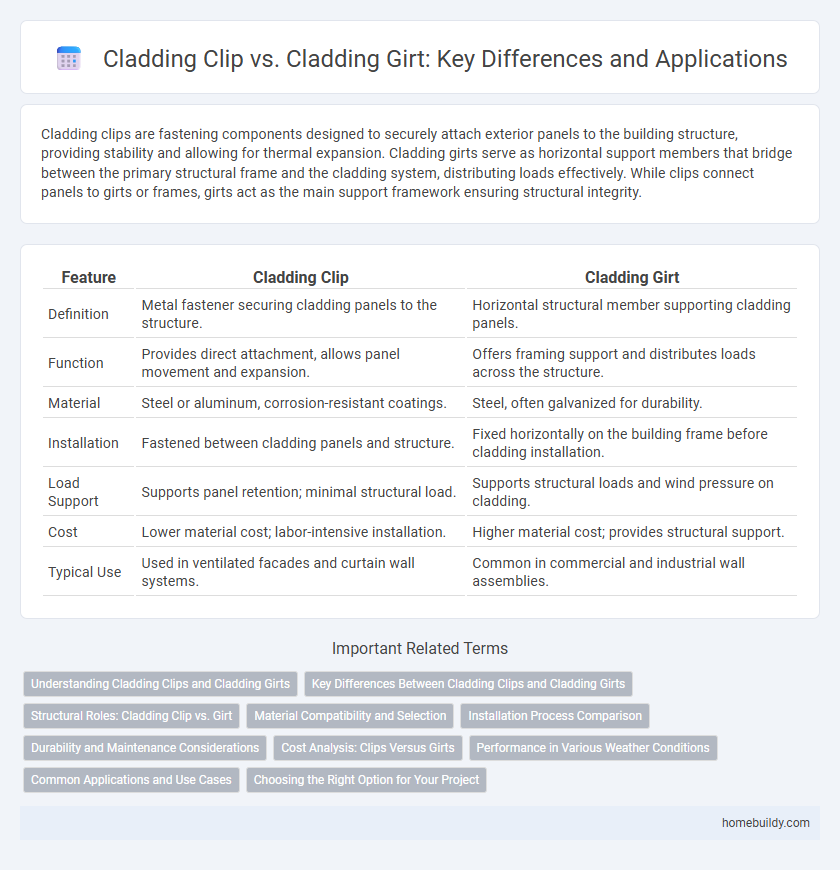Cladding clips are fastening components designed to securely attach exterior panels to the building structure, providing stability and allowing for thermal expansion. Cladding girts serve as horizontal support members that bridge between the primary structural frame and the cladding system, distributing loads effectively. While clips connect panels to girts or frames, girts act as the main support framework ensuring structural integrity.
Table of Comparison
| Feature | Cladding Clip | Cladding Girt |
|---|---|---|
| Definition | Metal fastener securing cladding panels to the structure. | Horizontal structural member supporting cladding panels. |
| Function | Provides direct attachment, allows panel movement and expansion. | Offers framing support and distributes loads across the structure. |
| Material | Steel or aluminum, corrosion-resistant coatings. | Steel, often galvanized for durability. |
| Installation | Fastened between cladding panels and structure. | Fixed horizontally on the building frame before cladding installation. |
| Load Support | Supports panel retention; minimal structural load. | Supports structural loads and wind pressure on cladding. |
| Cost | Lower material cost; labor-intensive installation. | Higher material cost; provides structural support. |
| Typical Use | Used in ventilated facades and curtain wall systems. | Common in commercial and industrial wall assemblies. |
Understanding Cladding Clips and Cladding Girts
Cladding clips are fasteners used to secure architectural panels to a building's structure, allowing for movement and minimizing stress on the panels. Cladding girts, by contrast, are horizontal structural members attached to the primary framing that support the cladding system and distribute loads. Understanding the distinct functions of cladding clips and girts is crucial for designing durable, efficient building envelopes with enhanced weather resistance and structural integrity.
Key Differences Between Cladding Clips and Cladding Girts
Cladding clips are small, fastener components designed to securely attach cladding panels to the building structure, offering flexibility and ease of installation. In contrast, cladding girts are horizontal support members that provide structural backing for cladding systems, bearing the load and distributing wind pressure. Key differences include the clip's role in panel attachment versus the girt's function as a primary structural support element within the wall assembly.
Structural Roles: Cladding Clip vs. Girt
Cladding clips secure external panels to the structural framework, ensuring weatherproofing and aesthetic alignment without bearing significant structural loads. Cladding girts act as horizontal structural members, distributing loads from cladding panels to the primary frame and providing support against wind pressure and other forces. Understanding the distinct roles of clips and girts optimizes facade performance and structural integrity in building envelopes.
Material Compatibility and Selection
Cladding clips are typically made from stainless steel or aluminum, ensuring excellent corrosion resistance and compatibility with metal, timber, and composite cladding materials. Cladding girts, usually fabricated from steel or aluminum, serve as structural supports but require careful selection based on load-bearing capacity rather than direct material compatibility with the cladding panels. Choosing the right material for cladding clips involves prioritizing durability and environmental conditions, while cladding girt selection focuses on structural integrity and integration within the building frame.
Installation Process Comparison
Cladding clips simplify installation by securely fastening panels to the building frame without the need for drilling, reducing labor time and minimizing material damage. Cladding girts require precise alignment and bolting, which can extend installation time and increase the risk of misalignment. Choosing cladding clips enhances efficiency and ensures consistent panel spacing, improving overall facade integrity.
Durability and Maintenance Considerations
Cladding clips offer superior durability due to their high corrosion resistance and secure fastening mechanism, reducing the risk of structural damage over time. In comparison, cladding girts, while essential for providing support, often require more frequent maintenance to address wear and environmental exposure. Choosing cladding clips minimizes long-term upkeep costs and enhances the overall lifespan of facade systems.
Cost Analysis: Clips Versus Girts
Cladding clips generally offer a lower initial cost compared to cladding girts due to reduced material usage and simpler installation processes. While cladding girts provide enhanced structural support and may reduce long-term maintenance expenses, their higher upfront investment can impact project budgets. Evaluating total cost of ownership, including labor, material, and durability factors, is essential for optimal budget allocation between cladding clips and girts.
Performance in Various Weather Conditions
Cladding clips outperform cladding girts in weather resistance by providing superior flexibility and secure fastening under thermal expansion and contraction. Their corrosion-resistant materials enhance durability against rain, wind, and temperature fluctuations, ensuring long-term structural integrity. Cladding girts, by contrast, may exhibit reduced adaptability and increased maintenance needs in harsh environments.
Common Applications and Use Cases
Cladding clips are primarily used for securing lightweight metal or composite panels to building structures, providing a flexible and hidden fastening solution ideal for facades, curtain walls, and rainscreens. Cladding girts serve as horizontal structural elements that support cladding panels and transfer wind loads to the main framework, commonly found in industrial buildings, warehouses, and large commercial projects. While clips ensure aesthetic integrity and allow for thermal movement, girts offer robust support and are essential for mounting heavy or large-area cladding systems.
Choosing the Right Option for Your Project
Cladding clips provide a secure and concealed fastening solution ideal for lightweight panels and quick installation, while cladding girts offer robust structural support suited for heavier cladding systems and larger spans. Selecting between cladding clips and cladding girts depends on factors such as panel weight, wind load requirements, and project budget, ensuring optimal durability and performance. Assessing these technical specifications helps achieve a balance between aesthetic appeal and structural integrity for your building envelope.
Cladding clip vs Cladding girt Infographic

 homebuildy.com
homebuildy.com